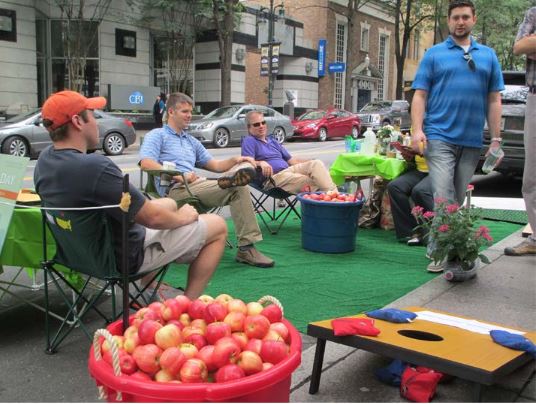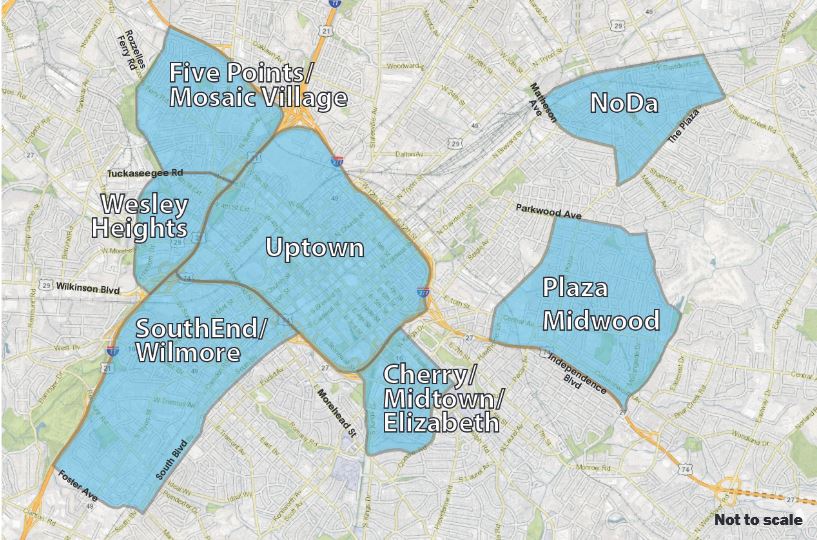Want a park in a parking spot? City says OK, as long as …

Last September, a group of enthusiasts pulled together a series of eight small parks-for-a-day in on-street parking spots along Tryon Street in uptown Charlotte. Now, the city’s Department of Transportation is offering its official stamp of approval to these “parklets.” Or at least, it’s offering a process for you to get a permit to install a small park where a parking spot now sits.
Download the Pilot Parklet Program manual here. |
What’s a parklet? The city’s Pilot Parklet Program manual explains: “A Parklet is a small public park serving as an extension of the sidewalk over an on-street parking space. … Typically Parklets are no more than two parking spaces long and extend out from the sidewalk to the width of the adjacent parking space.”
Why bother? Says the manual: “Parklets are a way to reclaim a small amount of public space to beautify and enliven our streets and neighborhoods.”
The Charlotte Department of Transportation has launched its Pilot Parklet Program “in response to recent requests by Charlotte residents to establish Parklets.” CDOT will evaluate the pilot program over the next year and decide whether to make it permanent in 2016.
Last fall Tryon Street sprouted eight parklets on Friday, Sept. 19, part of International PARK(ing) Day, a global event in which people take parking spots, designed for cars, and turn them into small temporary parks designed for people. (See “Parklets for a day to blossom in Tryon Street parking spots.”) The idea, said Keihly Moore, an urban designer who was one of the organizers, is to show examples of “how people can use public space other than for storing an empty vehicle.”

It was the third year in a row that Moore, an architecture and urban design graduate of UNC Charlotte who now lives in Boston, had worked with friends and volunteers to organize parklets for PARK(ing) Day. (The 2013 event was in NoDa, and the 2012 event was in South End.) The 2014 event received funding and other assistance from the John S. and James L. Knight Foundation, Charlotte Center City Partners, UNC Charlotte’s College of Arts + Architecture and a number of local design and architecture firms.
PARK(ing) Day and parklets are one small manifestation of a larger international trend called tactical urbanism (“Will tactical urbanism find a home in Charlotte?”), or in some cases urban acupuncture. The idea is to make inexpensive, creative changes to help people feel more comfortable mingling, walking, bicycling, or simply experiencing a place.
Scott Curry, CDOT’s pedestrian program manager, said the city started drafting the design manual in summer 2014. The subsequent September PARK(ing) Day event along Tryon Street helped city staffers see and understand the role of parklets, he said in an email interview. Charlotte Center City Partners will take the lead on the 2015 PARK(ing) Day event, he said.
A demonstration project is underway on South Church Street across from Romare Bearden Park, in cooperation with the Mecklenburg County Park and Recreation Department, which will maintain it, Curry said. An urban design studio at UNC Charlotte’s College of Arts + Architecture designed the parklet.
Keihly Moore cheered the new pilot program. “I’m really happy that the city is listening to our desires for more public spaces and different types of public spaces,” she said. “I hope they catch like wildfire. It just needed a spark from the three previous PARK(ing) Days.”
As with just about anything involving city right-of-way, there are some significant rules to follow. Parklets must be:
- Within marked, on-street parallel public parking spots where parking is usually allowed 24/7.
- In areas with existing pedestrian activity.
- On streets with speed limit of 35 mph or lower.
Parklets can’t be (see manual for complete list):
- Within 20 feet of intersections, within 10 feet of driveways and bus stops or within 5 feet of fire hydrants or stand pipes.
- In front of planting strips.
- Above manholes.
- On bridges.
- In any other location deemed inappropriate by the CDOT director.
Curry said no formal parklet applications have arrived but the city has received requests over the past year from people in the South End and NoDa neighborhoods. The manual offers a map of examples of neighborhoods where conditions might provide spots for parklets: Five Points/Mosaic Village outside Johnson C. Smith University, Wesley Heights, Cherry/Midtown/Elizabeth, etc.

Map courtesy Charlotte Department of Transportation